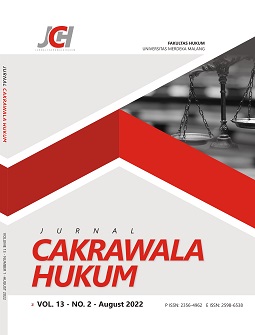Dinar Candy, pornography, freedom of expression, and the law
DOI:
https://doi.org/10.26905/idjch.v13i2.6517Keywords:
Pornography, Freedom of Expression, Law.Abstract
Dinar Candy expressed her feeling to PPKM by wearing bikini in the road-side which caused her be stipulated as the suspect of pornography. Dinar Candy’s case brought to the conception on the limitation of pornography interpretation and the determination on freedom of expression in action of wearing bikini. The research is conducted through a qualitative approach using secondary data. The results show, first: pornography is limited by ‘subjective reason’ such as if the pornography is aimed for personal interest, then the action is not pornography. The other is ‘action-room limitation’ in which an action can be formulated as pornography if the standard and characteristic in the room where the action is done considering that the action is obscene or aims to sexual exploitation. The room refers to specific places such as beach, roadside, hotel, or other specific place, not wide social room. Second: If someone’s feeling is expressed by wearing bikini in a room which based on its decency standard allows to wear bikini, then the action can be determined as freedom of expression. In contrary, in a room where bikini is considered against morality, or it is spread to public, then such action is against the pornography law.
How to cite item:Â
Donandi S, S. (2022). Dinar Candy, pornography, freedom of expression, and the law. Jurnal Cakrawala Hukum, 13(2), 202-213. DOI:https://doi.org/10.26905/idjch.v13i2.6517.
Downloads
References
Abbas, A. H. (2017). Telaah terhadap Undang-Undang Pornografi Perspektif Hukum Islam. Jurnal Al-‘Adl. Vol. 10 No. 1, Januari 2017. DOI: http://dx.doi.org/10.31332/aladl.v10i1.688.
Bunga, D. (2011). Penanggulangan Pornografi Dalam Mewujudkan Manusia Pancasila. Jurnal Konstitusi, 8(4), 453–478. DOI: https://doi.org/10.31078/jk.
Doherty, K. M. (1999). An analysis of obscenity and indecency regulation on the internet. In Akron Law Review (Vol. 32, Issue 2).
Ernes, Y. (2021). Pelapor Desak Polisi Tetapkan Dinar Candy Tersangka di Aksi Berbikini. DetikNews. Available at: https://news.detik.com/berita/d-5671204/pelapor-desak-polisi-tetapkan-dinar-candy-tersangka-di-aksi-berbikini.
Indarti, S. T. (2021). Kebijakan Keimigrasian di Masa Covid-19: dalam Perspektif Hak Asasi Manusia. Jurnal HAM, 12(1), 19. DOI: https://doi.org/10.30641/ham.2021.12.19-36.
Istighfaroh, M. (2019). Profil Lengkap Dinar Candy, DJ Seksi yang Soal Usul Semua Artis Jalani Tes Urine. Tribunnewswiki.Com. Available at: https://www.tribunnewswiki.com/2019/07/24/dinar-candy.
Laksana, A. W., & Suratman. (2014). Analisis Yuridis Penyidikan Tindak Pidana Pornografi Di Era Digitalisasi. Jurnal Pembaharuan Hukum, I(2), 169–177.
Layan, C. V. (2021). 8 Fakta Video Viral Dinar Candy Pakai Bikini di Pinggir Jalan. Available at: https://www.liputan6.com/news/read/4624839/8-fakta-video-viral-dinar-candy-pakai-bikini-di-pinggir-jalan.
Lumingkewas, F. (2016). Tindak Pidana Kesusilaan Dalam Kuhp Dan Ruu Kuhp Serta Persoalan Keberpihakan Terhadap Perempuan. Lex Crimen, 5(1), 21–27.
Marwadianto, M. (2020). Hak Atas Kebebasan Berpendapat dan Berekspresi. Jurnal HAM, 11(1), 1–4. Available at: https://ejournal.balitbangham.go.id/index.php/ham/article/view/976/pdf.
Mudjiyanto, B. (2019). Kebebasan Berekspresi dan Hoaks Freedom of Expression and Hoaks. Promedia, 5(1), 1–39. Available at: http://journal.uta45jakarta.ac.id/index.php/kom/article/view/1613.
Olivia, D. (2020). Pelaksanaan hak kebebasan berekspresi, tanpa adanya rasa takut atau campur tangan penting untuk eksis di tengah-tengah masyarakat yang demokratis, di mana setiap orang mendapatkan akses dalam menikmati hak asasi manusi. Law Jurnal Asasi Manusia Ringkasan, 1(2). DOI: http://dx.doi.org/10.36355/.v1i2.
Prahassacitta, V., Hasibuan, B. M., Bisnis, J. H., Humaniora, F., Bina, U., & Kijang, K. (2019). Dalam Penerapan Pasal Penghinaan Undang-Undang Informasi Dan Transaksi Elektronik Kajian Atas Putusan Pengadilan Periode Tahun 2010-2016. Jurnal Yudisial, Vol 12, No 1 DOI: http://dx.doi.org/10.29123/jy.v12i1.299. 61–79.
Rahmanto, T. Y. (2016). Kebebasan Berekspresi Dalam Perspektif Hak Asasi Manusia: Perlindungan, Permasalahan Dan Implementasinya Di Provinsi Jawa Barat. Jurnal HAM, 7(1), 45. DOI: https://doi.org/10.30641/ham.2016.7.45-53.
Rongkene, B. (2020). Tindak Pidana Pornografi Menurut Kuhp Dan Undang-Undang Nomor 44 Tahun 2008 Tentang Pornografi. Human Relations, 3(1), 1–8.
Saidah, M., & Irwansyah, I. (2019). Kebebasan berekspresi dan paradoks privasi dalam hubungan pertemanan. Jurnal Studi Komunikasi (Indonesian Journal of Communications Studies), 3(2), 215. DOI: https://doi.org/10.25139/jsk.v3i2.1683.
Sari, R. F. (2019). Menyoal Kebablasan Berpendapat: Malfungsi Media Sosial Sebagai Panggung Produsage Konten Negatif. Jurnal Penelitian Pers Dan Komunikasi Pembangunan, 23(1), 1-16. DOI: https://doi.org/10.46426/jp2kp.v23i1.86.
Selian, D. L., & Melina, C. (2018). Kebebasan Berekspresi Di Era Demokrasi: Catatan Penegakan Hak Asasi Manusia. Lex Scientia Law Review, 2(2), 189–198. DOI: https://doi.org/10.15294/lesrev.v2i2.27589.
Setiawan, R. (2017). Kebebasan Ekspresi Individual Dalam Pembangunan Manusia Era Digital. Prosiding Seminar Nasional Pendidikan FKIP UNTIRTA 2017, 169–178.
Sushanty, V. R. (2017). Pornografi Dunia Maya Menurut Kitab Undang-Undang Hukum Pidana, Undang-Undang Pornografi Dan Undang-Undang Informasi Elektronik. Journal of Chemical Information and Modeling, 53(9), 1689–1699.
Warong, K. M., Caecilia J. J., Waha, C. T. (2020). Kajian Hukum Hak Asasi Manusia Terhadap Kebebasan Berpendapat Oleh Organisasi Kemasyarakatan di Media Sosial. Lex Administratum, VIII(5), 2018–2020.
Yuniantoro, F. (2018). Eksploitasi Seksual Sebagai Bentuk Kejahatan Kesusilaan Dalam Peraturan Perundang-Undangan. Justitia Jurnal Hukum, 2(1). DOI: https://doi.org/10.30651/justitia.v2i1.1227.
Additional Files
Published
How to Cite
Issue
Section
License
Copyright (c) 2022 Jurnal Cakrawala Hukum

This work is licensed under a Creative Commons Attribution-ShareAlike 4.0 International License.
Authors who publish in this journal agree to the following terms:
The copyright of the received article shall be assigned to the journal as the publisher of the journal. The intended copyright includes the right to publish the article in various forms (including reprints). The journal maintains the publishing rights to the published articles. Authors must agree to the copyright transfer agreement by checking the Copyright Notice column at the initial stage when submitting the article.









